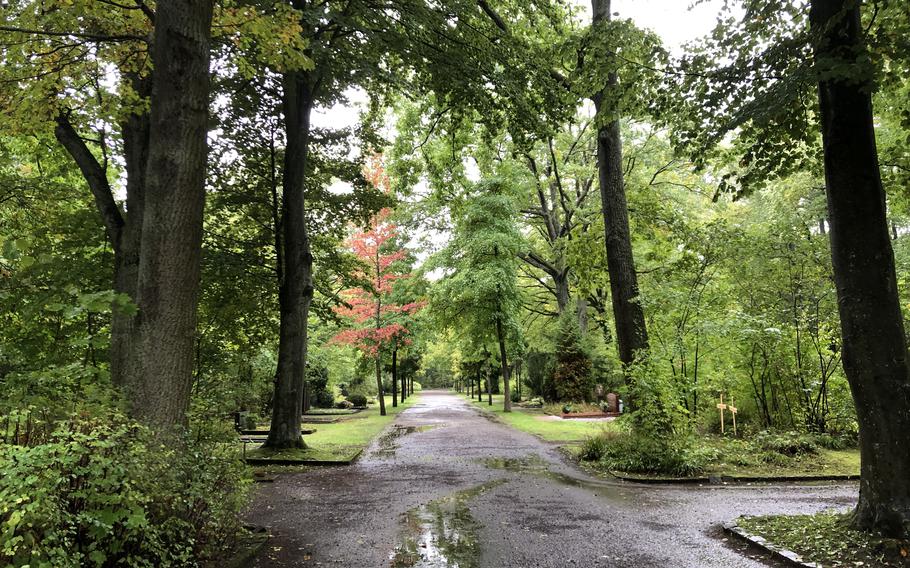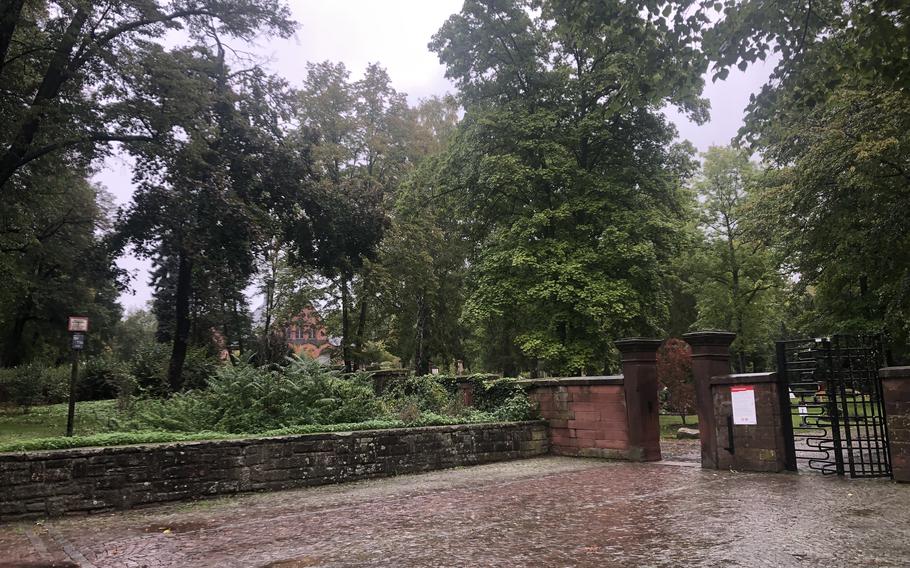
Beautiful tree-lined paths cross throughout Hauptfriedhof Kaiserslautern. The cemetery is celebrated as a conservation area with at least 70 bird nesting boxes installed on trees on the grounds. (Heather Benit/Stars and Stripes)
Buried beneath the oak and linden trees in the southeast side of Kaiserslautern’s largest cemetery are the graves of 451 infants born to American military families stationed there in the 1950s and ’60s.
The Hauptfriedhof, near the U.S. Army’s Daenner Kaserne and Kleber Kaserne, sprawls across parklike grounds, giving residents a placid place to meditate and mourn.
For Americans, visiting the cemetery offers a connection to the German city at the heart of the largest U.S. military community overseas as well as a chance to remember their predecessors’ young children who were laid to rest there.
Every year, Germans and Americans come together for a memorial ceremony and place flowers and U.S. flags at the stone markers that dot the Kindergraves section.
The babies who are buried there died soon after being born at Landstuhl or nearby local hospitals from 1952 to 1971, during a time when the Red Cross and U.S. military didn’t pay to send the remains back to the U.S.
The site is located east of the cemetery’s main entrance on Mannheimerstrasse, across from the Kleber clock tower.
The outer cemetery wall that runs along Mannheimerstrasse leads to the old Jewish cemetery, which is the oldest section, dating from 1858. The rest of the cemetery was expanded around it in 1873.
Just beyond the Mannheimerstrasse entrance, is the majestic Lion Fountain, which was built in 1917 and 1918 as part of a cemetery expansion. There are benches around the fountain — among the 400 throughout the cemetery, according to The Rheinpfalz newspaper — and people often sit there while reflecting, reading or watching the wildlife.
The city recently installed 70 new bird nesting boxes around the cemetery, the Wochenblatt reported.
On the northeast side is a forest cemetery that was laid out with tree-lined paths in 1912. Also on that side, there is a military section dating from 1870 that contains the plots of German service members killed in the Franco-Prussian War, World War I and World War II.
It’s not unusual to see soccer fans decked out in red-and-white 1.FCK scarves roaming the cemetery looking for the grave of legendary local player Fritz Walter, for whom the Kaiserslautern team’s stadium is named.
Die-hard devotees have been making a pilgrimage to the world champion’s final resting place since 2002, when he died at age 81.
At the edge of the cemetery next to Daenner Kaserne, east of the American Kindergraves, is a section called Sternerwiese, or star meadow, a burial ground for stillborn babies who weighed less than 1.1 pounds.
The annual memorial ceremony for the Kindergraves won’t be held again until after Mother’s Day, but the cemetery is open all year.
benit.heather@stripes.com

An entrance to Hauptfriedhof Kaiserlautern, the city’s main cemetery, on the corner of Donnersburgstrasse and Mannheimerstrasse. (Heather Benit/Stars and Stripes)
On the QT
Address: Donnersbergstrasse 78, Kaiserslautern, Germany
Hours: Visitors can walk the grounds from 8 a.m. to 8 p.m.
Cost: Entrance is free; free parking is available near the chapel on Donnersbergstrasse.
Restrictions: Bikes and dogs are not allowed at the cemetery.